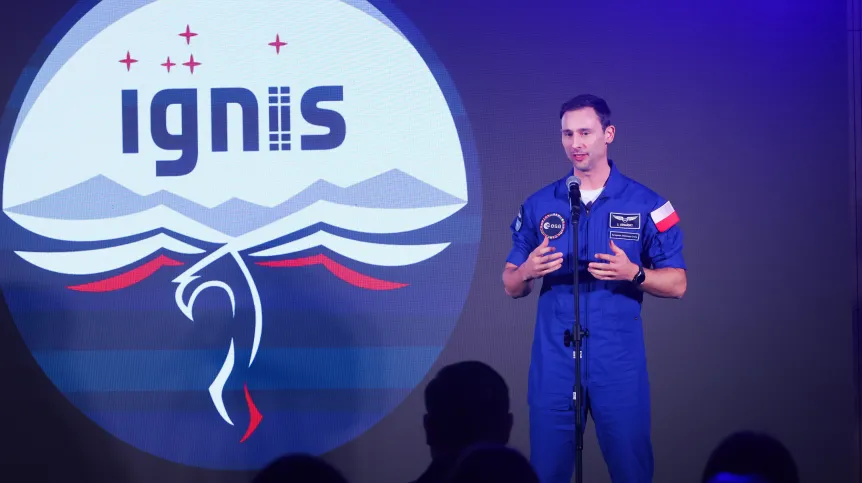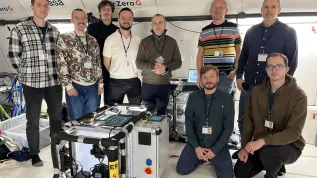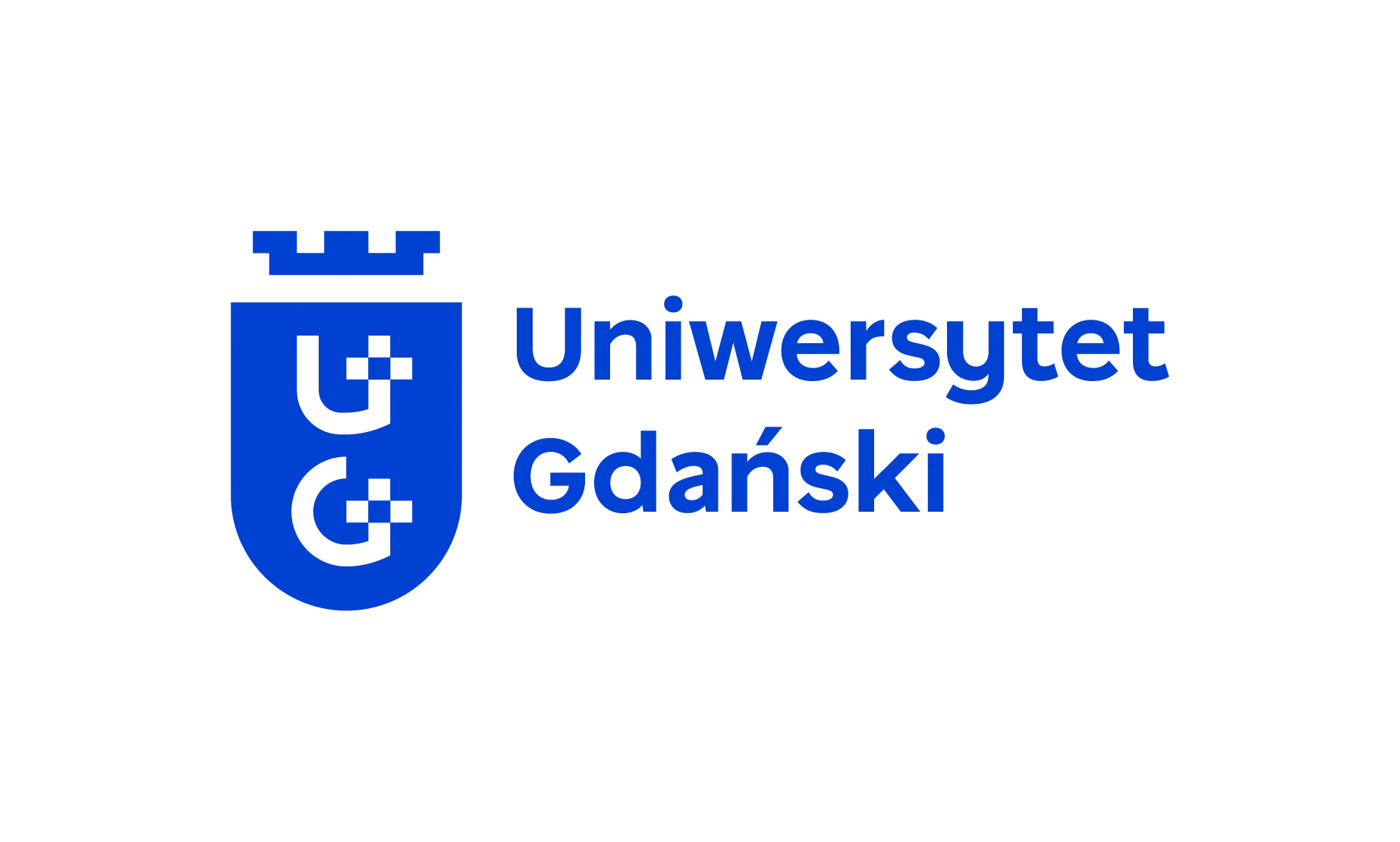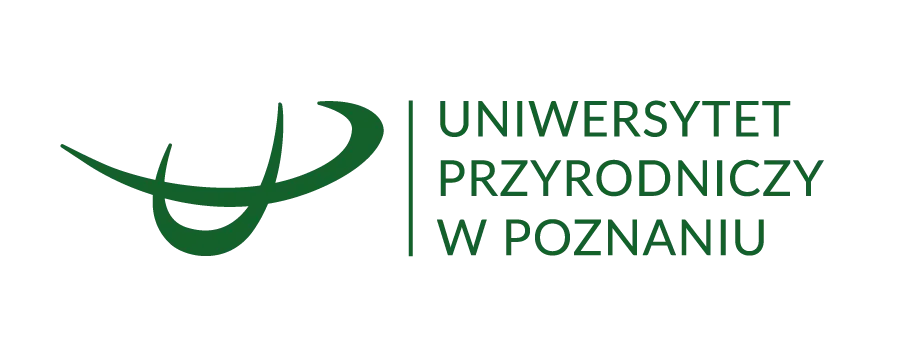
Sławosz Uznański-Wiśniewski will fly into space. He will be the second Pole in history, after Mirosław Hermaszewski. However, many of our compatriots have contributed to space exploration.
Everyone in Poland knows the legend of Sir Twardowski, a sixteenth-century nobleman called the 'Polish Faust', who flew to the Moon - some say that he was carried there by a rooster, others - by the devil, whom Twardowski offered his soul in exchange for learning the knowledge and secrets of magic. According to the German version of the legend, the protagonist of the story was a German educated in Wittenberg, Laurentius Dhur, from Latin Durentius, which means 'hard', hence his Polonised surname (which could be loosely translated into 'Hardy').
However, the only actual Polish cosmonaut was Brigadier General Mirosław Hermaszewski, a military pilot. He was born on September 15, 1941, in Lipniki, Volhynia. As a child, he was saved by his mother from the UPA attack on Lipniki in March 1943. During the Volhynian massacre, he lost 19 members of his family, including his father. In 1945, the Hermaszewskis were displaced from the Eastern Borderlands to Lower Silesia. They settled in Wołów near Wrocław.
He was an active member of the Wrocław Aeroclub from 1960. He joined the Air Force Academy in Dęblin, from which he graduated in 1964 as a second lieutenant. In 1962, he joined the Polish United Workers' Party. He graduated with distinction from the General Staff Academy in Warsaw, and served in the National Air Defence Forces, from 1976 as a major. As commander of the 11th Fighter Aviation Regiment of the Lower Silesian Settlers' Air Force Base in Wrocław, he was among 300 cosmonaut candidates in the international Intercosmos Programme established by the USSR. The backup candidate for the flight was Zenon Jankowski (Sławosz Uznański-Wiśniewski has no backup).
The authorities of the Polish People's Republic insisted that Poland, the USSR's main trading partner and an ally during World War II in the fight against the Third Reich, should have priority in space flights. Moscow decided that the first to fly into space would be representatives of Czechoslovakia and Poland, probably because the social situation in both countries was unfavourable to the authorities. Czechoslovakia had the dissident movement Charter 77, and in Poland the society was dissatisfied with price increases. The authorities, albeit undemocratic, needed an event that would distract public opinion, pork barrel politics. Ironically, the Polish cosmonaut's first flight brought a joke about the 'Hermaszewski sausage': 'There's a vacuum inside, and if you try it, your eyes will pop out of their sockets'.
On December 4, 1976, Hermaszewski and Jankowski flew to the Star City near Moscow, where they would spend a year and a half preparing for a space flight.
On March 2, 1978, a Czech, Vladimir Remek, flew into space. On June 27, it was Mirosław Hermaszewski's and Piotr Klimuk's (Byelorussian SSR) turn to take off aboard the Soyuz 30 spacecraft from the Baikonur Cosmodrome in Kazakhstan. For most Poles, the news came as a complete surprise - the broadcast of a show for farmers was interrupted and the national emblem appeared on TV screens. Some thought that the war had begun...
After two days, the Soyuz connected with the Salyut 6 orbital station, where two other Soviet cosmonauts were waiting - Vladimir Kovalonok and Aleksandr Ivanchenkov. After completing the research programme, on July 5, they landed in the steppe of Kazakhstan. During the 8-day mission, 126 orbits of the Earth were completed and several Polish records approved by the FAI were set; including: altitude - 363 km, flight speed - 28 thousand km/h, flight duration - 190 hours 3 minutes 4 seconds, distance travelled - 5,273,257 km. In a 2018 interview for Rzeczpospolita, the Polish cosmonaut said that the sunrises he watched with each subsequent orbit were not only an aesthetic experience for him but also a spiritual one. He could also see Poland from above.
According to an ancient Russian custom, a warm kiss on the lips is a sign of friendship and respect, which is why Brezhnev kissed Honecker and Carter. The televised scene of the kiss in zero gravity, which Mirosław Hermaszewski and Aleksandr Ivanchenkov exchanged, inspired Maciej Zembaty to write the Ballad of Major Hermaszewski, performed at the True Song Festival in Gdynia (August 21, 1981).
For his participation in the mission, Mirosław Hermaszewski was awarded the Golden Star of the Hero of the Soviet Union, the Order of Lenin and the Order of the Cross of Grunwald, First Class. The list of later decorations is long (for example, the Order of the Smile). On July 22, 1978, he was promoted to the rank of lieutenant colonel. In Poland, postage stamps and a coin (PLN 20) with his image were issued.
During martial law (1981–1983), Hermaszewski was a formal member of the Military Council of National Salvation. At that time, he studied in Moscow at the Military Academy of the General Staff. He claimed that he was mad a member of the Military Council of National Salvation without his knowledge.
In the years 1987–1990 he was the commander of the Air Force Officer Training College in Dęblin. From December 1989 to June 1990 - deputy head of the Main Educational Board of the Polish Army. 1991–1992 he was the deputy commander of the Air Forces and Air Defence, and Flight Safety Chief in 1992–1995. From 1995, he was an Air Force Inspector at the General Staff of the Polish Army. He retired after 40 years of service.
On October 5, 2005, he completed a farewell flight aboard the MiG-29UB fighter. In total, he spent 2047 hours and 47 minutes in the air, he performed 3473 takeoffs and landings - as well as 10 training parachute jumps. In 2003, Mirosław Hermaszewski was awarded the Commander's Cross of the Order of Polonia Restituta.
In 2018, the government of Mateusz Morawiecki prepared a law to degrade people who in the years 1943–1990 worked against the Polish raison d'etat, including all members of the Military Council of National Salvation. The act, already passes by the parliament, was vetoed by President Andrzej Duda, citing General Hermaszewski as an example of the person who should not be deprived of a military degree under the act.
Hermaszewski died on December 12, 2022 at the age of 81, as a result of complications after surgery. He was buried in the Military Cemetery in Powązki in Warsaw. The state celebrations with the participation of the Polish Army Representative Company included the tribute flight of four F-16 fighters over the necropolis. The wreaths were sent, among others, by the Russian embassy and Piotr Klimuk.
Many other Poles before Mirosław Hermaszewski had a contribution to space exploration. Nicolaus Copernicus, born in 1473, created a Heliocentric Solar System model and made one of the greatest breakthroughs in science, called Copernican Revolution. According to his model, the Earth ceased to be the centre of the Universe and became one of the many planets. Copernicus presented his vision in the work De revolutionibus orbium coelestium (On the Revolutions of the Heavenly Spheres). There are still disputes whether the author of the work was more Polish or German; he certainly worked in Poland and was a Polish king's subject.
Kazimierz Siemienowicz, a military engineer and artillery theoretician, born in the 17th century in Samogitia, was the author of the book Artis Magnae Artilleriae pars prima (Great Art of Artillery part one), which remained the basic artillery textbook in Europe for almost 200 years. In this textbook he discussed, among other things, the technology of producing combat rockets, including multi-stage ones, and the construction of a delta wing, used as a rocket stabilizer - instead of the previously used long pole. All currently used rockets capable of leaving the gravitational field of the Earth are multi-stage rockets - individual stages are ejected when their fuel runs out. Poland, Lithuania and Belarus all consider Siemienowicz to be their pride.
One of the greatest space flight visionaries, pioneer of cosmonautics, creator of the model of space rocket theory and construction, Konstantin Eduardowicz Ciołkowski (1857-1935) was associated primarily with Russia and considered himself to be Russian, but his father, Edward Ciołkowski, was a Polish official, and his mother, Maria Jumaszewa, was a Russian of Tatar origin. As Ciołkowski himself said, 'he combined Russian, Polish, Tatar and as it would seem, also Ukrainian blood'.
His achievements include the theory of multi-stage rocket movement in the Earth's gravitational field, theoretical foundations for the construction of liquid fuel rocket engines, and a proposal to use gyroscopic stabilizers in rockets. Ciołkowski believed that thanks to the colonisation of space, people would become perfect and immortal.
Ary Sternfeld, born in 1905 in Sieradz in a Jewish family, was already interested in space flights during his studies, which did not meet with enthusiasm in Poland. In France, his ideas were more appreciated, but they did not have practical possibilities of implementation. Sternfeld's book Initiation à la Cosmonautique (Introduction to Cosmonautics), awarded the REP-Hirsch Award, was the first to introduce the concept of 'cosmonautics'. Sternfeld dealt with rocket flight aerodynamics issues, the problem of weightlessness, spacecraft designs and possible satellite trajectories. In 1935 he moved to the Soviet Union, where he later joined the Soviet space programme. The first Sputnik circled the orbit he proposed. Ary Sternfeld died in Moscow in 1980.
Professor Mieczysław Bekker, head of the General Motors Institute in Santa Barbara in the early 1960s, together with his team won a NASA competition for a vehicle capable of moving around the Moon as part of the Apollo space program. Bekker was the author of all technical solutions of the Lunar Roving Vehicle (LRV), which enabled moving on the surface of the Moon, the most famous of which were 'tires' made of piano wire. The electrically powered vehicle was built by General Motors in cooperation with Boeing, and three units went to the Moon as part of the Apollo 15, 16 and 17 missions. Bekker died in 1989 in Santa Barbara.
Another Pole working for the Apollo program was Eugeniusz Lachocki, an engineer born in 1921 in Prużany in Polesie (now Belarus). During the war, he was sent to Kazakhstan, he joined the Anders army and fought in the battle of Monte Cassino. Later, he took up electronics and gained recognition working for American companies. He was entrusted with ambitious tasks for NASA, he developed the efficient and reliable power sources based on hydrogen fuel cells and silver-zinc cells for radio communication and television devices installed in the Moon lander, the power supply for Bekker's LRV, and later power supply modules for space shuttles. He died in 2010.
Born in 1921 in Warsaw, Wojciech Rostafiński fought in the Warsaw Uprising and was awarded Virtuti Militari. Although he was captured by Germans, he managed to survive the war and emigrated to the US, where he joined NASA in Cleveland. He worked there 33 years, mainly dealing with liquid oxygen and hydrogen pumps, and axial compressors used in liquid fuel engines. He contributed to the creation of the Saturn V lunar rocket, which reached the Moon many times instead of explode during the tests due to construction defects like the Soviet N1 did. He died in 2002 in Cleveland.
Other Poles also made a significant contribution to the Apollo program. Werner Ryszard Kirchner, born in 1918 in Opole, who fought in the British 317 Vilnius Hunting Squadron (he was awarded the Cross of Valour three times), became a chemist after the war (he was inspired by the view of a rocket destroying the German tank). He worked on fuels for larger rocket (Polaris and Minuteman ballistic missiles). Wernher von Braun himself, whom Kirchner met while studying at MIT, pulled him into NASA, where he developed fuel for the Eagle Moon lander, among other things.
Born in 1923 in Vilnius, Stanisław Stankiewicz (Stanley Stanwyck-Stankiewicz) was a soldier of the 2nd Polish Corps during World War II. After arriving in the US he joined the United States Marine Corps. As a sergeant, he fought in the Korean war, from which he returned a disabled veteran. This did not prevent him pursuing a scientific career. He received a doctoral degree in the field of thermodynamics and began working as a flight engineer at NASA. He participated in the Skylab program and the work related to the Apollo 11 mission. He developed a special oxygen mix for astronauts, which allowed to reduce the pressure in the cabin and decreased the risk of a fire.
Kazimierz Piwoński, born in 1920, in Bytoń in Kujawy, served in the 307th Lviv Night Hunting Squadron. After the war, he emigrated to the US, where he designed the so-called Randez Vous Radar, i.e. a radar enabling a randez vous of the Apollo ship with the LM lunar vehicle in orbit, and the return of astronauts to Earth. He died in the USA in 1996.
Professor Michał Kleiber (Minister of Science and Computerisation in 2001-2005) in the 1980s worked at the University of Stuttgart and at the University of California, Berkeley. He dealt with modelling and computer simulations of behaviour of parts of space vehicles during the flight, including the Columbia space shuttle, still at the stage of its design.
Artur Bartłomiej Chmielewski, born in 1957 in Warsaw, works at the NASA Propulsion Laboratory in California as a space missions manager. He has participated in such international projects as Rosetta, Galileo, Ulysses and Cassini-Huygens missions.
The American astronauts of Polish origin include: James Anthony 'Jim' Pawelczyk, who took the Polish flag on his space flight; Scott Edward Parazynski, who took the badge of the Kościuszko Squadron with him; George David 'Zambo' Zamka (Colombian-Polish origin); Christopher John Ferguson (Scottish-Polish origin) and the late Karol Joseph 'Bo' Bobko.
Paweł Wernicki (PAP)
pmw/ bar/ mhr/













